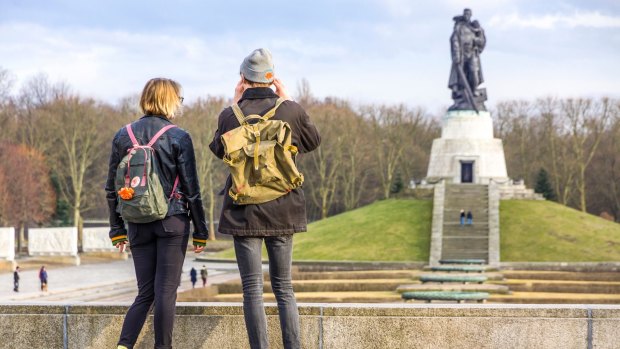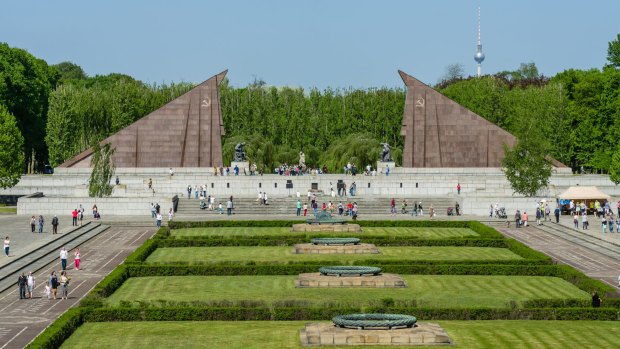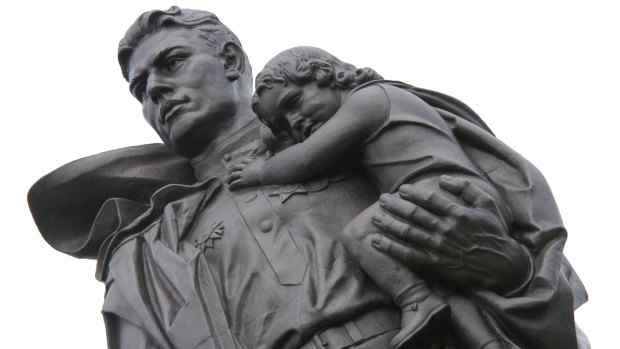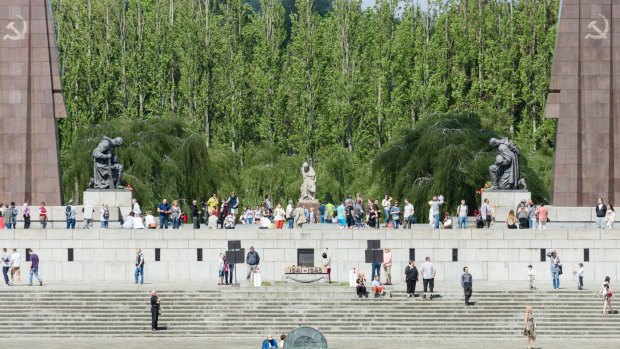This was published 5 years ago
Treptower Park, Berlin: Germany's largest Soviet war memorial is a controversial monument
By Mark Chipperfield

Sites such as Treptower Park provide a glimpse into Berlin's anguished soul.Credit: Shutterstock
On a relaxed, blue-sky afternoon a gaggle of teenage boys in T-shirts and torn jeans are showing off their skateboarding skills. Clattering down the granite steps of Berlin's Treptower memorial they whoop for joy before racing back up to the top.
"I think this is a stupid place to skateboard," says my guide, Kathinka Minthe, curtly. "But it probably makes good Instagram pictures, right?"
As a child of the Cold War, Kathinka is acutely aware of the solemn significance of Treptower Park, which commemorates the 80,000 Russian troops who died in the ferocious Battle of Berlin in 1945.

Designed by the Soviet architect Yakov Belopolsky, the nine-hectare park on the banks of the Spree was completed in May 1949 and expresses the belligerent, unyielding mood of the world's first communist superpower.Credit: Shutterstock
"Treptower Park is the largest Soviet war memorial in Germany – you won't see anything like this anywhere else in western Europe," she says. "But it's also a military cemetery. The ashes of 7000 Red Army troops are buried here."
Designed by the Soviet architect Yakov Belopolsky, the park, which covers nine hectares on the banks of the Spree, was completed in May 1949 and expresses the belligerent, unyielding mood of the world's first communist superpower.
"As a statement of architectural propaganda it's very powerful, don't you think?" says Kathinka.

The 12-metre figure of a Soviet soldier set atop a small man-made hill is modelled on Sergeant Nikolai Masalov and carries a child in one arm.Credit: Shutterstock
Visitors to the park are first greeted by a three-metre-tall sculpture of Mother Russia grieving for her fallen sons before turning into an avenue of weeping willows leading to a jagged, geometric arch guarded by the bowed figures of two Soviet soldiers. The two pillars, built in red granite, represent the Soviet flag.
From here a series of tiered lawns and sarcophagi lead to the Herculean 12-metre figure of a Soviet soldier set atop a small man-made hill. The soldier, modelled on Sergeant Nikolai Masalov, carries a child in one arm and in the other a massive sword piercing a shattered swastika; to underline their triumph over the Nazis, the Soviets used granite from Hitler's shattered New Reich Chancellery to construct their sprawling war memorial.
While the iconography of death employed at Treptower Park will be familiar to anyone who has visited military cemeteries elsewhere, there is something peculiarly unsettling about memorialising a political ideology that inflicted so much suffering on the German people.

Treptower Park has a guaranteed future: under the terms of its unification Germany is required to pay for the upkeep of all three Soviet war memorials in Berlin – the others are in the Tiergarten and Schonholzer Heide.Credit: Shutterstock
In Stasiland, Anna Funder details the apparatus of repression employed in the German Democratic Republic from 1949 to the fall of the Berlin Wall. "At the end, the Stasi [State Security Service] had 97,000 employees," she writes. "But it also had over 173,000 informers among the people."
While much of Berlin's Cold War past has been obliterated – only fragments of the Wall survive and Checkpoint Charlie is a crude facsimile – Treptower Park has a guaranteed future; under the terms of its unification Germany is required to pay for the upkeep of all three Soviet war memorials in Berlin – the others are in the Tiergarten and Schönholzer Heide.
"Every so often there's a debate in the newspapers about the Soviet memorial in the Tiergarten," says Kathinka. "Because it's flanked by two T-34 tanks people think it's too militaristic and want it deconstructed, but that's never going to happen."
Dealing with Berlin's communist legacy is no less challenging than coming to grips with the scale of atrocities perpetrated by the Third Reich. Earlier, I'd spent 40 minutes exploring the city's Memorial to the Murdered Jews of Europe, a vast labyrinth of concrete slabs and passageways. Both experiences left me feeling unsettled and drained.
For a non-German, Berlin remains a city of unfathomable complexity and unimaginable suffering. Sites such as Treptower Park provide a glimpse into the city's anguished soul, but provide no answers and little solace. "No other city has repeatedly been so powerful and fallen so low," writes historian Rory MacLean. "No other capital has been so hated, so feared, so loved."
Trip Notes
FLY
Etihad Airways flies from Sydney and Melbourne to Berlin's Tegel Airport, via Abu Dhabi. See etihad.com
STAY
As its name suggests, the Adina Apartment Hotel Checkpoint Charlie is walking distance from some of Berlin's most famous Cold War landmarks and has pleasant one-bedroom apartments from $250 a night. See adinahotels.com
VISIT
Berlin Private Tours (berlinprivatetours.com) offers escorted walking tours of Treptower Park and other Cold War and Nazi-era monuments. Entry to the park, about seven kilometres from Alexanderplatz, is free.
Sign up for the Traveller Deals newsletter
Get exclusive travel deals delivered straight to your inbox. Sign up now.